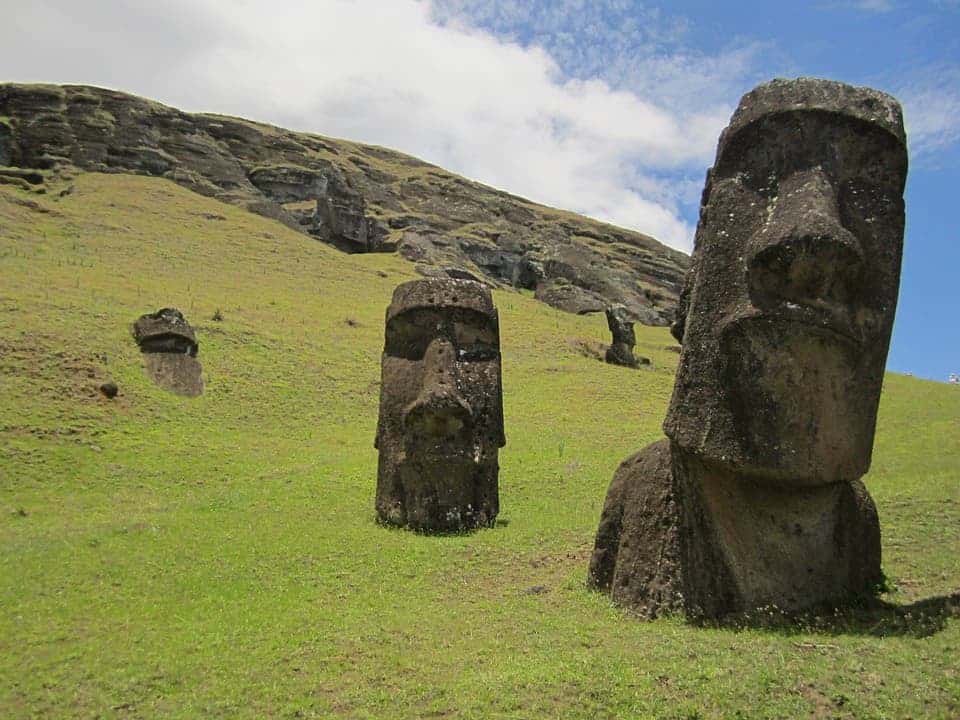
Easter Island is one of the most mysterious cultural landmarks in the world. Located smack in the middle of the South Pacific Ocean and a staggering 2,300 miles away from South America, the island is littered with over 1,000 massive carved statues called Moai. Easter Island became even more interesting in 2014 when a paleogenomics analysis found Polynesian natives had mixed with Native Americans at least 19 generations ago, between 1280 and 1495 or long-before Europeans had set foot on the island for the first time in 1722. However, a new study published today in Current Biology contradicts the findings suggesting the islanders remained isolated until they made contact with Europeans.
Buzzkill
Lars Fehren-Schmitz, associate professor of anthropology at UC Santa Cruz, led the team that analyzed bone fragments from the ancient skeletal remains of five individuals. Three individuals lived prior to European contact, and two lived after.
Fehren-Schmitz had expected to find evidence of Native American gene flow in the pre-European contact individuals but none of the individuals who lived between the 13th and 19th centuries showed any sign of Native American ancestry.
“We were really surprised we didn’t find anything. There’s a lot of evidence that seems plausible, so we were convinced we would find direct evidence of pre-European contact with South America, but it wasn’t there,” Fehren-Schmitz said in a press release.
The 2014 study made waves, finding that the genomes of 28 modern Rapanui (Easter Island natives) inherited 8% of their DNA from Native American ancestors. Signs pointed towards mixing between the two populations many generations before any European set foot on the island. This immediately conjured the image of daredevil Polynesians manning their wooden outrigger canoes, making a spectacular journey more than 2,000 miles across the ocean where they made contact with American Natives. The presence of crops native to the Americas in Polynesia, including the Andean sweet potato, long before the first reported European contact, strengthened this image.
The new findings, however, dispell this theory.
It could be that the pre-Columbian individuals that Fehren-Schmitz et al. analyzed came from isolated families that had yet to contact the Native American genetic signature, which would have already been present on the island in other individuals. After all, the initial study sampled 28 individuals while this time only five individuals were analyzed. Maybe, but Fehren-Schmitz’s hypothesis is far more plausible.
“This study highlights the value of ancient DNA to test hypotheses about past population dynamics,” said Fehren-Schmitz. “We know the island’s modern populations have some Native American ancestry, and now we know that early inhabitants did not. So the big questions remain: Where and when did these groups interact to change the genetic signature of Easter Islanders?
When Europeans first made contact with Native Americans in the 16th century, they made sure to “civilize” the locals with their way of life. Slavery and mass deportation soon followed. By the time the first Native American slaves arrived at Easter Island in the 18th century, they would have already had short-bursts of European and Native American DNA in their genomes. So after Polynesian Rapanui mixed with the continental people, the genetic analysis could have fooled us that the Native American genome was present on the island long before Europeans made contact.
The bottom line is that ascertaining the history of a whole culture of people is an extremely complex affair if genes are all you have to work with. It’s likely, however, that this is not the last word on the matter.
“We want to do more work to determine more precisely when this gene flow between Native Americans and the people of Rapa Nui occurred, and where in the Americas it originated,” Fehren-Schmitz said. “The population dynamics of these regions are fascinating. We need to study the ancient populations of other islands—if remains exist.”
Scientific reference: Current Biology, Fehren-Schmitz and Jarman et al.: “Genetic Ancestry of Rapanui before and after European Contact” DOI: 10.1016/j.cub.2017.09.029.






